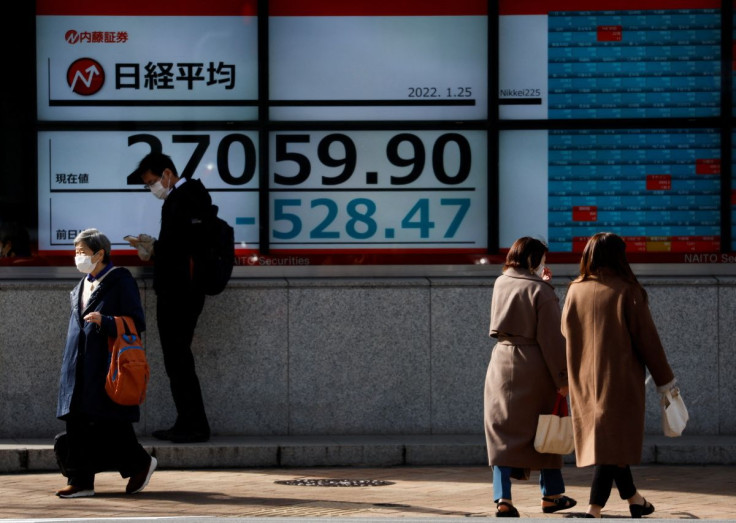Stocks Regroup As Investors Hold Their Breath On Ukraine

Asian stocks steadied on Wednesday and demand for safe-havens waned a little as investors regarded Russian troop movements near Ukraine and initial Western sanctions as leaving room to avoid a war, while a rate hike lifted New Zealand's dollar.
Commodity prices remain elevated, however, and traders are still nervous over the situation on Europe's eastern edge.
Overnight oil struck a seven-year high while the S&P 500 index tipped into correction territory, having dropped more than 10% from January's record peak. [O/R][.N]
S&P 500 futures were up 0.55% in Asian trade, after U.S. President Joe Biden left the door open to diplomacy as he announced sanctions on two Russian banks and some elites close to President Vladimir Putin.
MSCI's broadest index of Asia-Pacific shares outside Japan rose 0.3%. Japan's Nikkei was closed for the Emperor's birthday holiday.
"The market sees the various sanctions ... as modest and perhaps not as aggressive as feared," said Chris Weston, head of research at brokerage Pepperstone.
"For now, one could assess there is a vibe across markets that Russian troops will hold Donbass, but push no further," he added, referring to the parts of eastern Ukraine that Russia has recognised as independent and has sent troops to reinforce.
The European Union and Britain also announced plans to target banks and Russian elites while Germany halted Russia's Nord Stream 2 gas pipeline, leading to a nearly 11% leap in Europe's benchmark gas price.
Japan followed on Wednesday, with Prime Minister Fumio Kishida saying the nation is prohibiting the issuance of Russian bonds in Japan and freezing the assets of certain Russian individuals as well as restricting travel to Japan.
Wheat futures had also leapt on Tuesday, posting the sharpest leap in three-and-a-half years and corn futures hit an eight-month high on concern that conflict could disrupt grain supply from the Black Sea export region. [GRA/]
Brent crude futures were last steady at $97.09 a barrel, having eased off Tuesday's top of $99.50. U.S. crude futures sat at $92.2 a barrel.
CENTRAL BANKS TOO
The crisis in Ukraine and the potential for surging energy prices come on top of nerves about whether the global economy can handle rising interest rates.
"That's what's weighing on markets - the uncertainty around how hard and fast central banks will go and what it does to the economy in terms of slowing it down," said Kerry Craig, global market strategist at J.P. Morgan Asset Management in Melbourne.
Aidan Yao, senior emerging Asia economist at AXA Investment Managers, told the Reuters Global Markets Forum that the Fed and other central banks would now need to contend with both market sentiment and rising energy prices.
"So it's a rock and a hard place - the onus will be on the Fed to make sure spikes in commodity prices don't morph further into inflation expectations and wage/pricing behaviours," he said.
The Reserve Bank of New Zealand announced its third consecutive rate hike on Wednesday, lifting its benchmark cash rate by 25 basis points to 1%, as expected, but surprising investors with a hawkish tone.
The New Zealand dollar rose 0.6% on the news and is on its longest streak of daily gains in almost two years. [NZD/]
China is a notable outlier where rates are falling and, according to a private research group, banks in nearly 90 cities have cut mortgage rates this month.
Elsewhere in currency markets, moves were fairly muted, though hopes that war in Ukraine can be avoided took some of the bid from safe-havens. [FRX/]
The yen was steady at 115.00 per dollar, having hit 114.50 a day ago. The euro hovered around its 50-day moving average at $1.1331.
The Australian dollar, which has been supported by surging commodity prices, touched a two-week high of $0.7241.
Cash Treasuries were closed in Asia due to the holiday in Tokyo but benchmark 10-year futures were steady and showed an implied yield of 1.97%. [US/]
Precious metals eased from overnight highs but remain bid on nerves about war. Gold was steady at $1,898 an ounce and is up more than 8% from December lows, while platinum and palladium have surged on fears about supply disruption. [GOL/]
Platinum is up more than 20% since December and palladium has gained more than 50%.
© Copyright Thomson Reuters 2024. All rights reserved.




















